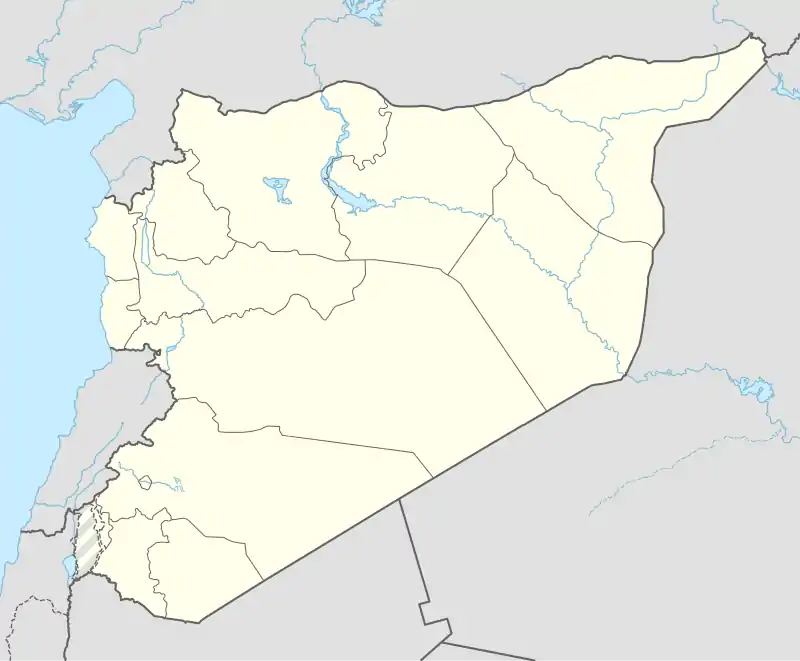Dhibin
Dhibin (Arabic: ذيبين; also spelled Dhaybin or Thibin) is a village in southern Syria, administratively part of the Salkhad District of the al-Suwayda Governorate. It is located south of al-Suwayda, near the southern border with Jordan. Nearby localities include Bakka to the north, Salkhad to the northeast, Umm al-Rumman to the east, Samaj to the west and Samad to the northwest. In the 2004 census it had a population of 2,562. It is the administrative center of the Dhibin Nahiyah, which consisted of three villages with a collective population of 6,900 in 2004.[1]
Dhibin
ذيبين Dhaybin, Thibin | |
|---|---|
 Dhibin Location in Syria | |
| Coordinates: 32°26′13″N 36°33′53″E | |
| Grid position | 297/205 |
| Country | |
| Governorate | As-Suwayda |
| District | Salkhad |
| Subdistrict | Dhibin |
| Population (2004) | |
| • Total | 2,562 |
History
Dhibin was a mainly grain-growing village in the late 16th century, during Ottoman rule.[2] In the Ottoman tax registers of 1596, it was a village located the nahiya (subdistrict) of Butayna, in the qadaa (district) of Hauran. It had a population of twelve households and four bachelors, all Muslims. They paid a fixed tax-rate of 25% on agricultural products, including wheat, barley, summer crops, goats and beehives, in addition to occasional revenues; a total of 1,000 akçe.[3]
By the early 19th century, the village had been abandoned like many of the other villages of Jabal Hauran due to Bedouin depredations.[2] Druze migrants from other parts of Syria populated the villages of Jabal Hauran by the 1860s. Dhibin became part of the sheikhdom of the Bani al-Atrash clan under the leadership of Ismail al-Atrash between 1860 and 1867.[4] The inhabitants of Dhibin moved to annex and seasonally inhabit the village of Umm el-Jimal (in modern-day Jordan) in 1909.[5] Dhibin's families divided the ruins of its ancient houses among themselves in 1910.[5] They lived there on and off until around 1930, when they permanently abandoned Umm al-Jimal.[5] Dhibin was the birthplace of Salim Hatum, a Syrian Army officer and key participant in the Baathist-led 1966 Syrian coup d'état.[6]
Archaeology
Funerary material from the Middle Bronze Age has been found at Dhibin.[7] A mid-4th-century inscription on a ruined building recording the name of Roman emperor Valentinian I has been found in the village as well.[8]
References
Bibliography
- Akkermans, P.; Schwartz, Glenn M. (2003). The Archaeology of Syria: From Complex Hunter-Gatherers to Early Urban Societies (c. 16,000-300 BC). Cambridge University Press.
- Batatu, H. (1999). Syria's Peasantry, the Descendants of Its Lesser Rural Notables, and Their Politics. Princeton University Press. ISBN 0691002541.
- Brown, Robin M. (2009). "The Druze Experience at Umm al-Jimal: Remarks on the History and Archaeology of the Early 20th Century Settlement" (PDF). Studies in the History and Archaeology of Jordan. Amman. X.
- Firro, Kais (1992). A History of the Druzes, Volume 1. BRILL. ISBN 9789004094376.
- Hütteroth, Wolf-Dieter; Abdulfattah, Kamal (1977). Historical Geography of Palestine, Transjordan and Southern Syria in the Late 16th Century. Erlanger Geographische Arbeiten, Sonderband 5. Erlangen, Germany: Vorstand der Fränkischen Geographischen Gesellschaft. ISBN 3-920405-41-2.
- Kennedy, D. (2004). The Roman Army in Jordan (PDF). The Council for British Research in the Levant.
External links
- Map of the town, Google Maps
